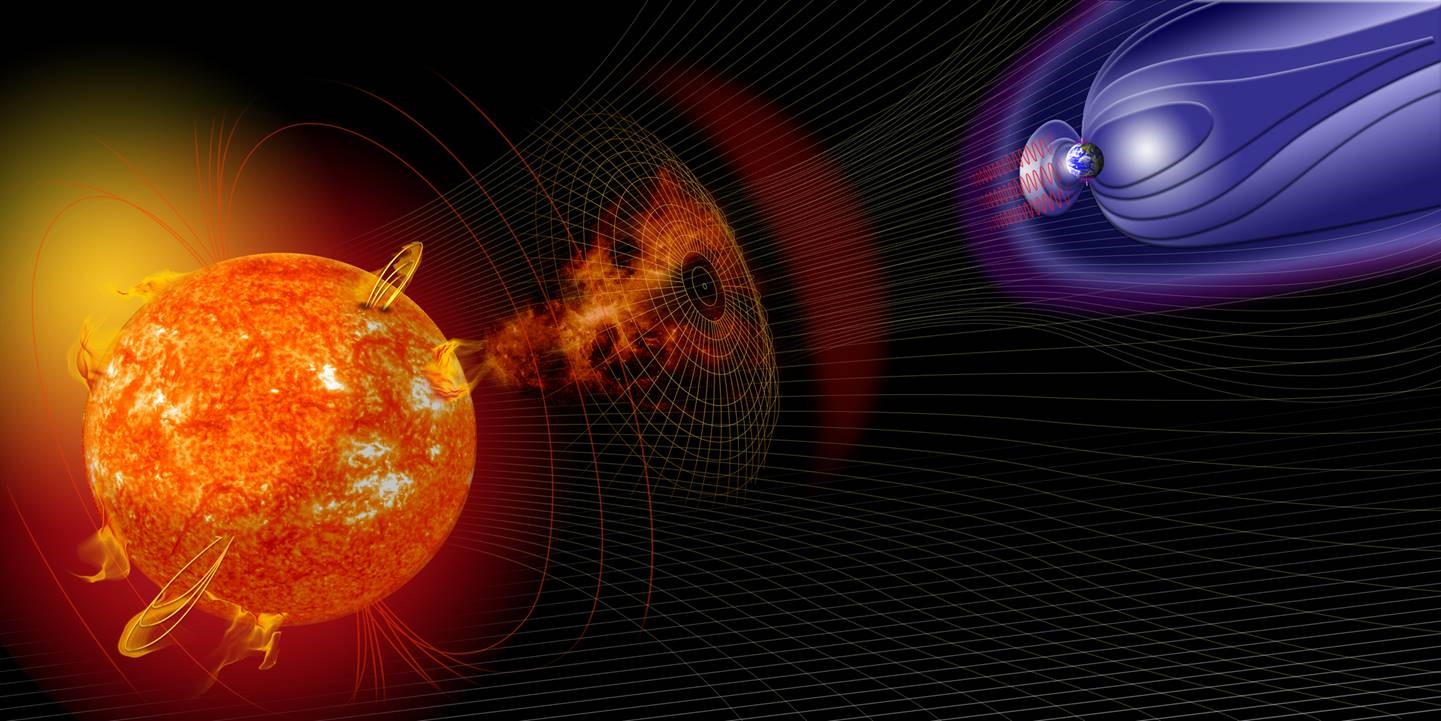Critical Infrastructure
This page (also available as a PDF fact-sheet) contains information to assist in the protection of Critical Infrastructure (CI) from severe space weather.
Subscribe to the Bureau's Severe Space Weather Warning email service.
What is Space Weather?
The term space weather refers to events beyond the Earth's atmosphere that impact upon our technology and the near-Earth space environment. The primary source of space weather is the sun, with the greatest disturbances usually caused by solar flares and subsequent geomagnetic storms.
Solar flare eruptions are sometimes associated with:
- increased X-ray and radio emissions that reach Earth within eight minutes (sometimes up into the ultra-high frequency (UHF) band);
- an increase in the flux of energetic protons typically reaching Earth in 30 minutes to six hours (referred to as solar energetic protons or solar energetic particles or SEPs) and
- an increase in the mass and velocity of solar wind particles and magnetic field strength reaching Earth typically within half a day to three days (collectively termed a coronal mass ejection or CME).
On reaching Earth, a CME may cause geomagnetic and ionospheric storms. All these phenomena can have an impact on technologies in the near-Earth space environment.
For further information please view the following video: Space Weather Impacts and Extremes
Extreme Space Weather Events and Critical Infrastructure
Since the emergence of the space age in the late 1950s, and particularly over the past few decades, we are increasingly reliant on technologies that are susceptible to space weather.
The benchmark for extreme space weather is the Carrington event, named after Richard Carrington who first reported the solar flare event in 1859 after viewing a large flare. The geomagnetic storm that followed has been analysed to be a number of times larger than any other event in the space age.
Modern technology is yet to experience the one-in-100-year, or more, space weather event, so it is difficult to assess the likely impacts on today's connected world. However, we gained insight through Quebec's blackout of 1989 when a large solar flare and resulting CME, roughly a third as powerful as the Carrington event, knocked out power to six million customers in less than two minutes. Over recent years there have been increasing efforts to understand the possible risks to critical infrastructure posed by such low-frequency, high-impact events and how best to mitigate them.
It is considered that the worst-case scenario in Australia may result in:
- partial loss of satellite infrastructure and disruption to satellite communications;
- significantly degraded and unreliable precision (position), navigation and timing (PNT) systems;
- intermittent disruptions to very high frequency (VHF)/UHF telecommunications systems;
- loss of high frequency (HF) communications systems, and
- possible power supply instability and transformer damage—while widespread loss of power is unlikely, prolonged outages to major metropolitan areas could occur.
Satellites
The near-Earth space environment contains energetic particles which are hazardous to satellite infrastructure. Space weather events can lead to significant increases in the particle levels, increasing the risk of 'dielectric discharge' and 'single-event upset' events on satellites, causing loss of data and/or control. Some operators may place satellites into 'safe mode' during intense particle radiation events to mitigate damage. In addition, during intense geomagnetic and ionospheric storms the upper atmosphere is heated and expands, possibly leading to increased drag on low-orbit satellites. Further, satellite signals can experience 'scintillation' effects (a rapid fluctuation in the signal strength due to ionospheric irregularities) in particular regions and short duration (minutes) interference during intense solar radio emissions.
Satellite Navigation Systems
One of the largest sources of error in global positioning systems (GPS) or PNT signals is due to the passage of the satellite signal through the relatively dense electron environment of the upper atmosphere. These errors are typically compensated for by using correction models. During ionospheric storms or periods where the ionosphere deviates from normal conditions the models may be inadequate and lead to errors. Precision navigation systems that autocorrect for the ionosphere, such as differential GPS, may be susceptible to errors during severe ionospheric storms. GPS may also be susceptible to interference from solar radio bursts in the UHF range, leading to significant loss of satellite availability for tens of minutes (in severe cases).
High-Frequency Communications
Background radiation produced by the sun in the extreme ultraviolet (EUV) and X-ray range is typically absorbed at altitudes above 90 km, in a region known as the ionosphere. This region supports the HF radio communication used by defence, aviation and emergency service sectors. Emissions associated with solar flares and SEP events produce ionisation of the Earth’s upper atmosphere at lower altitudes, which causes increased absorption of HF radio communications, leading to radio 'blackouts' or loss of HF communications.
VHF/UHF Systems
Solar radio bursts have been shown to interfere with VHF/UHF signals when base station antennae are aligned in a particular direction at a particular time of day and coincide with an intense solar radio burst. In severe cases, the interference may last for tens of minutes.
Power and Energy Systems
During geomagnetic storms there are relatively shortterm variations of the Earth's magnetic field. These result in an electric field in the Earth's surface which can drive currents (referred to as geomagnetically induced currents or GICs) through long grounded conductors such as power grids and pipeline networks. The GICs can flow through high-voltage power transformers and cause them to operate outside their optimum performance range, resulting in overheating and possible failure, system harmonics, unwanted power consumption and instability in the power system. Under extreme conditions, power restrictions or outages may occur. GICs flowing in pipelines cause an increased rate of corrosion, reducing asset lifespan.
Further Information
The Bureau of Meteorology's Space Weather Services section provides space weather information and services to the Australian region and beyond. A service focusing on forecasting and monitoring the severe to extreme events most likely to be of threat to critical infrastructure in the Australian region can be found under the Warnings section on the mailing list page.





